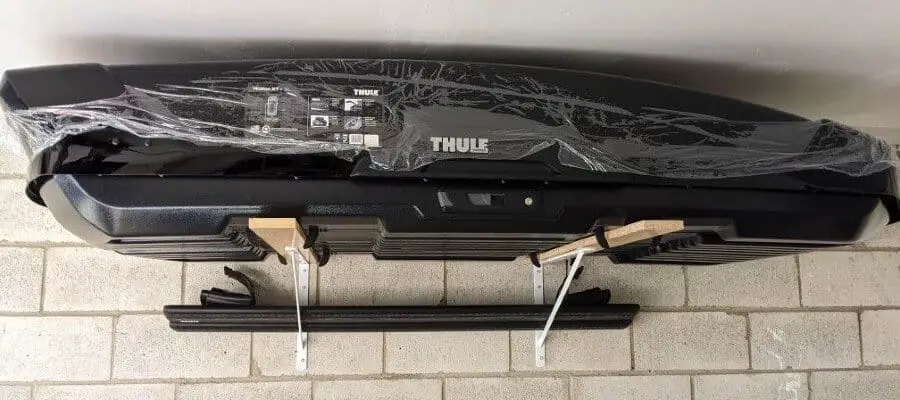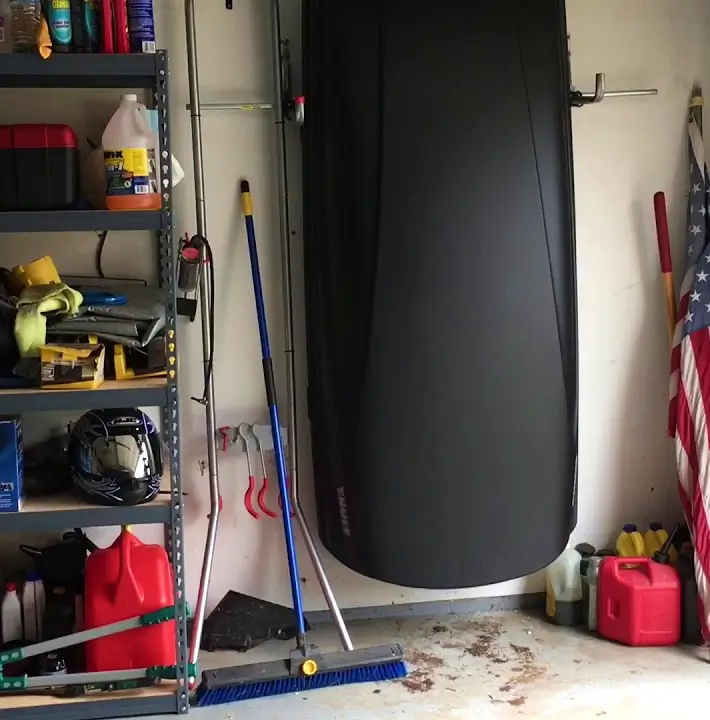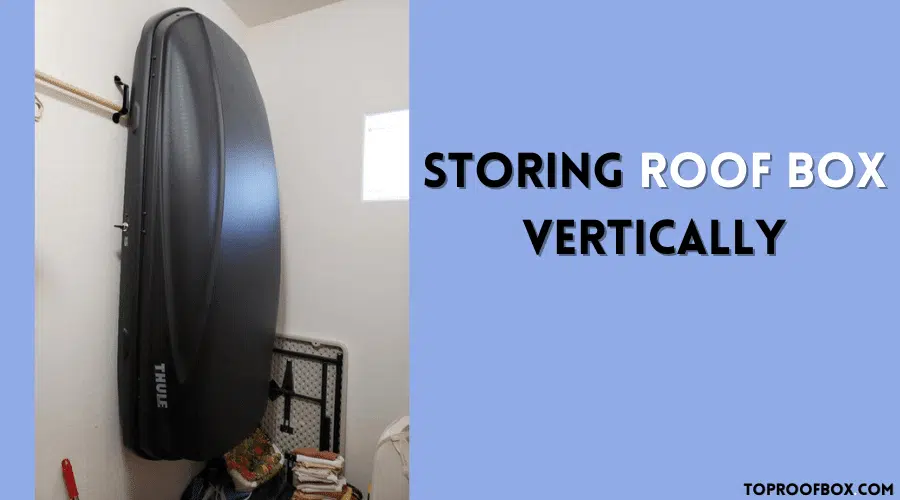Most people store their roof boxes horizontally, but it’s actually better to store them vertically. This will help prolong the life of your roof box and keep it in good condition. Plus, it takes up less space this way.
Here’s how to do it:
First, find a spot where you can store your roof box vertically. It should be indoors and away from direct sunlight or any other source of heat.
If you don’t have a lot of space, you can put it in the garage or even in the basement. Just make sure that the area is clean and dry so that your roof box doesn’t get damaged.
Next, open up the roof box and take out all of the contents.
This includes any bags or items that you have stored inside of it. Once everything is out, close the lid and turn the roof box upside down.
If you have a roof box, you may be wondering if it’s better to store it vertically or horizontally. The answer really depends on your situation and what works better for you. Here are some things to consider:
Key Takeaways
- If you have a lot of space in your garage or storage area, storing the roof box vertically may be the best option. This way, it takes up less space and is less likely to get in the way.
- On the other hand, if space is tight, storing the roof box horizontally may be a better option. This way, you can still access everything in the box easily without having to move it around too much.
- Another thing to consider is how often you use your roof box. If you only use it occasionally, vertical storage may be fine since you won’t need to access it as often.
However, if you use it frequently, horizontal storage may be more convenient so that you don’t have to keep moving it around every time you need to use it. Ultimately, there is no right or wrong answer when it comes to storing a roof box – it all depends on your individual situation and needs. What works best for one person may not work for another, so just go with whatever will work better for YOU!
Thule Cargo Box Wall Hanger
A wall hanger is an easy way to keep your Thule cargo box out of the way when not in use. It mounts to the wall and has a strong steel construction that can hold up to 50 lbs. The hanger is adjustable so you can customize the height to fit your needs.
How to Store Thule Cargo Box?
If you’re like most people, your car is one of your prized possessions. You take care of it, keep it clean and polished, and make sure it’s always in good working order. So when you need to transport large items or a lot of gear, you want to be sure you’re using the best possible method to protect your investment – and that’s where a Thule cargo box comes in.
Here are some tips on how to store your Thule cargo box so it will be ready for action when you need it:
- When not in use, keep the cargo box stored in a cool, dry place. Extreme temperatures can cause the materials to break down over time, so avoid storing it in direct sunlight or near heat sources.
- If possible, disassemble the cargo box into its individual parts before storing. This will help save space and prevent damage from things bumping into it while it’s stored away.
- Use soft cloths or blankets to wrap any sharp edges on the cargo box – this will help protect both the box and anything else that might come into contact with it while it’s being stored.
- Make sure the area where you’re storing the cargo box is clean and free of debris that could potentially scratch or damage the unit.
- Always store heavy items on the bottom of the cargo box to prevent them from crushing lighter items underneath them.

How to Store a Roof Box Outside?
When you’re not using your roof box, it’s important to store it properly to keep it in good condition. If you live in an area with harsh weather conditions, it’s especially important to take measures to protect your roof box from the elements. Here are some tips for storing a roof box outside:
If possible, store your roof box in a garage or shed. This will protect it from direct sunlight and precipitation. If you don’t have access to a garage or shed, cover your roof box with a tarp when not in use.
Make sure the tarp is securely fastened so that it doesn’t blow away in windy conditions. In very cold climates, consider storing your roof box inside during the winter months. This will prevent ice and snow from damaging the exterior of the box.
Be sure to clean your roof box before storing it away for extended periods of time. Remove all debris and wipe down the surface with a mild soap and water solution. Dry completely before covering or storing indoors.
Roof Box Wall Mount
A roof box wall mount is a great way to keep your roof box securely in place. This type of mount is designed to be installed on the wall of your garage or shed, and it provides a secure location for your roof box to be stored when not in use. The wall mount also allows you to easily access your roof box, so you can quickly and easily load it up when you need to use it.
There are a few things to consider when choosing a roof box wall mount. First, you need to make sure that the mount is compatible with the specific model of roof box that you have. Most mounts are designed to fit standard-size boxes, but there are some models that are specifically designed for larger or smaller boxes.
Make sure to check the specifications of the mount before purchasing it. Next, you need to decide where you want to install the wall mount. It’s important to choose a location that is out of the way and won’t interfere with any other activities in your garage or shed.
Once you’ve selected a spot, mark off the area where the screws will go into the wall so you know exactly where to drill pilot holes. Finally, use heavy-duty screws and anchors to secure the wall mount in place. Now that you know how to install a roof box wall mount, all that’s left is loading up your box and hitting the road!
Cargo Box Hanger
A cargo box hanger is a type of storage device that is used to store and organize various types of boxes. These devices are often used in garages, warehouses, and other storage areas where space is limited. Cargo box hangers are typically made from heavy-duty materials such as steel or aluminum, which makes them durable and able to support a large amount of weight.
There are many different types and sizes of cargo box hangers available on the market, so it is important to choose the right one for your needs.
Roof Box Storage Brackets
Most people don’t think about roof box storage brackets when they’re shopping for a new roof box. But the truth is, these brackets are just as important as the roof box itself. Without them, you wouldn’t be able to securely attach your roof box to your car.
There are a few things to consider when choosing the right storage bracket for your needs. First, you need to make sure that the bracket is compatible with your specific roof box model. Additionally, you’ll want to choose a bracket that’s easy to install and remove, so you can take it on and off as needed.
Finally, consider the weight capacity of the bracket – you don’t want it to break under the weight of your belongings!
Once you’ve found the perfect storage bracket for your needs, attaching it to your car is simple. Just follow the instructions included with your purchase, and you’ll be ready to hit the road in no time.
Roof Box Garage Storage System
If you’re like most people, your garage is full of stuff. And if you’re like most people, that stuff is crammed into every nook and cranny, taking up valuable space that could be used for other things – like your car! But what if there was a way to get all that stuff off the floor and out of the way, without having to get rid of any of it?
Enter the Roof Box Garage Storage System. This unique system utilizes the unused space above your head to create an extra storage area for all those things that are currently taking up valuable real estate in your garage. The Roof Box system consists of a series of heavy-duty plastic boxes that stack on top of each other, creating a sturdy platform for storing just about anything.
The boxes are designed to fit snugly together, so there’s no worry about them toppling over (even when they’re full). And because they’re made from plastic, they’re easy to clean – just hose them down when they get dirty. The beauty of the Roof Box system is that it’s completely modular, so you can add as many or as few boxes as you need to accommodate your particular storage needs.
And because the boxes are clear, it’s easy to see what’s inside – no more rummaging around looking for that one thing you know is in there somewhere! If you’re looking for a way to get organized and reclaim some valuable space in your garage, the Roof Box Garage Storage System is definitely worth checking out.
Diy Cargo Box Storage
Organizing your car can be a pain, especially when you have a lot of gear to lug around. A cargo box is a perfect solution for storing all your essential items without taking up too much space. Here’s a step-by-step guide to building your own cargo box storage system:
- Start by measuring the area where you want to install your cargo box. This will help you determine the size of the box you need.
- Cut out panels of plywood or MDF that will fit snugly into your car’s trunk or backseat area. Make sure to leave enough space for any passengers that may be riding with you.
- Attach these panels together with screws or nails, forming a basic rectangular box shape. If you’re using plywood, make sure to seal the edges with waterproof glue to prevent moisture damage.
- Line the inside of your box with carpeting or another soft material to protect your belongings from scratches and scuffs. You can also add dividers at this point if you want compartments for specific items.
- Drill holes in the sides of your box and run bungee cords through them, looping them over hooks or other supports in your car’s interior. This will keep everything securely in place while you’re driving. Finally, screw or bolt the lid onto the top of your box, and you’re ready to hit the road!
Can You Store a Roof Box Upright?
A roof box is a great way to increase the storage space in your car, but can you store it upright? The answer is yes, but there are a few things to keep in mind.
First, make sure that the roof box is securely fastened to the roof rack.
If it’s not, it could fall over and damage your car or injure someone.
Second, be aware of the weight of the roof box when storing it upright. If it’s too heavy, it could topple over.
Make sure to store it in a place where it won’t be knocked over by accident.
Third, consider the weather when storing your roof box upright. If it’s windy, the box could blow over.
In extreme heat or cold, the materials of the roof box could warp or crack. Choose a sheltered spot out of direct sunlight or severe weather if possible.
By following these simple tips, you can safely store your roof box upright and make the most of its storage space!
Can You Store a Roof Box on Its Side?
If you’re short on storage space, you might be wondering if you can store your roof box on its side. The answer is yes, but there are a few things to keep in mind. First, make sure that the roof box is secured so that it doesn’t topple over and damage anything.
Second, be aware that storing a roof box on its side can affect its aerodynamics and how well it cuts through the wind. Finally, keep an eye on the weatherstripping to make sure that it doesn’t get damaged or brittle from being stored in an unusual position. With these considerations in mind, storing your roof box on its side should be no problem.

How Do You Store a Vertical Roof Box?
When you’re not using your vertical roof box, it’s important to store it properly to keep it in good condition. Here are some tips for storing your roof box:
1. If possible, store the roof box indoors in a cool, dry place. This will help protect it from the elements and prevent any damage.
2. If you must store the roof box outdoors, make sure it is in a shady spot out of direct sunlight. It’s also a good idea to cover the roof box with a tarp or other type of protective covering.
3. Always make sure the roof box is securely fastened before storing it away. This will help prevent any accidental opening or damage while the roof box is being stored.
How Do You Store a Roof Box When Not in Use?
If you have a roof box, you know how great they are for storing extra gear when you’re on the road. But what do you do with your roof box when you’re not using it? Here are some tips on how to store your roof box so it stays in good condition and is ready to use when you need it.
First, if possible, store your roof box inside. This will protect it from the elements and keep it from getting too dirty. If you must store your roof box outside, cover it with a tarp or similar material to protect it from the sun and rain.
Once your roof box is protected from the elements, make sure to empty it out completely. Any items left inside will add weight and could cause the roof box to warp or become misshapen over time. If there are any items in your roof box that could leak or spill, such as liquids or batteries, be sure to wrap them securely before storing them in the roof box.
Finally, give your roof box a good cleaning before putting it away. This will remove any dirt or debris that could cause problems later on. Once your roof box is clean and dry, close all of the latches and locks to keep everything secure.
How to Store a Thule Car Roof Carrier, Where to store?
Conclusion
Roof boxes are a great way to add extra storage space to your car, but they can take up a lot of room when not in use. If you’re short on space, you can store your roof box vertically. This will save you a lot of room and make it easier to access when you need it.
To store your roof box vertically, first, remove any items from the box that could fall out. Next, find a wall or other vertical surface that is strong enough to support the weight of the box. Use straps or rope to secure the box to the surface, and make sure that it is level so that it doesn’t tip over.

